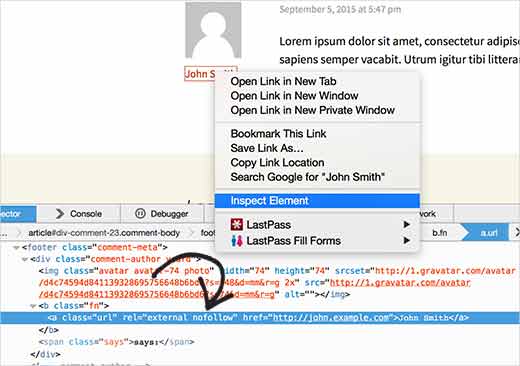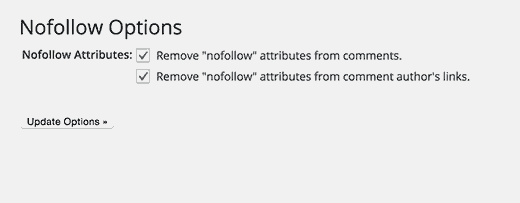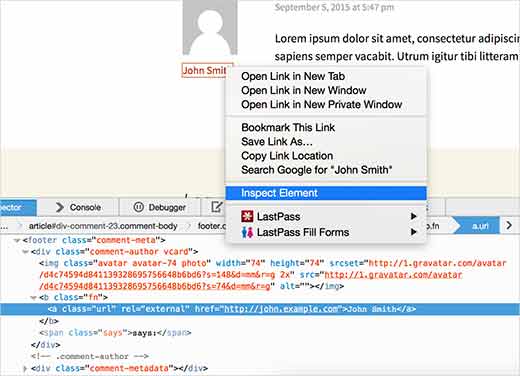Standardmäßig fügt WordPress automatisch ein nofollow-Tag zu allen Links in den Kommentaren hinzu. Kürzlich fragte einer unserer Leser, ob es möglich sei, das nofollow aus WordPress-Kommentaren zu entfernen? In diesem Artikel zeigen wir Ihnen, wie Sie nofollow aus WordPress-Kommentar-Links entfernen können und erläutern die Vor- und Nachteile dieser Vorgehensweise.
Was ist NoFollow?
Im Jahr 2005 führte Google das Attribut rel=”nofollow” für Links ein. Dieses Attribut weist die Suchmaschinen einfach an, dass Sie die genannten Links nicht unterstützen.
<a href="http://www.example.com" rel="nofollow">Beispiellink</a>

Warum wird NoFollow automatisch in WordPress-Kommentare eingefügt?
Früher war eine der einfachsten Möglichkeiten, Backlinks aufzubauen und SEO zu manipulieren, das Kommentieren von Blogs für Backlinks. Dadurch stieg die Zahl der Spam-Kommentare.
Der Zweck des nofollow-Tags war es, Blog-Kommentare für SEO-Manipulationen weniger effektiv zu machen.
Da die Hauptmotivation für Kommentarspam darin bestand, Backlinks zu erhalten, würde das nofollow-Tag die Spammer demotivieren.
Deshalb hat WordPress rel=nofollow eingeführt, das automatisch zu allen Links in den Kommentaren hinzugefügt wird.
Gut oder schlecht?
Die Hinzufügung von nofollow zu allen ausgehenden Links in Kommentaren verschafft Blog-Besitzern eine gewisse Beruhigung. Wenn nun ein Spam-Kommentar versehentlich veröffentlicht wird, wird er automatisch mit nofollow versehen.
Allerdings hat das nofollow-Attribut den Kommentarspam nicht vollständig beseitigt. Den Spammern war es einfach egal, und sie gingen davon aus, dass auch ein nofollow-Link etwas wert ist.
Andererseits wurden einige Blogger und Leser davon abgehalten, Kommentare abzugeben, weil sie das Gefühl hatten, dass sie für ihren Beitrag zu Ihrem Artikel keinen Wert erhielten.
Sollten Sie NoFollow in WordPress-Kommentaren deaktivieren?
Der Grund, warum manche Website-Besitzer NoFollow deaktivieren möchten, ist, dass sie mehr Kommentare fördern möchten.
Wenn Sie Links dofollow machen, erhöht sich zwar die Anzahl der Kommentare, aber auch der Kommentarspam.
WordPress führt ein PHP-Skript aus, wenn jemand einen Kommentar abgibt. Mehr Kommentare bedeuten mehr Instanzen des PHP-Skripts auf Ihrem Server. Dies könnte auch Ihre Website verlangsamen, und Ihr WordPress-Hosting-Anbieter ist möglicherweise nicht in der Lage, die Last zu bewältigen.
Der meiste Kommentarspam wird von Spambots eingereicht und kann mit Akismet leicht abgefangen werden. Wenn jedoch nofollow deaktiviert ist, erhalten Sie viel mehr minderwertige Kommentare, die von echten menschlichen Nutzern eingereicht werden.
Sie verbringen dann mehr Zeit mit der Moderation von Kommentaren als mit dem Schreiben von Inhalten auf Ihrer Website.
Wir empfehlen, nofollow für Blog-Kommentare nicht zu deaktivieren. Wir empfehlen sogar, nofollow zu externen Links in Ihren Blogbeiträgen hinzuzufügen, die Sie nicht befürworten (siehe Titel und nofollow zum Einfügen von Link-Popups in WordPress hinzufügen).
Sollten Sie dennoch fortfahren wollen und nofollow aus WordPress-Kommentaren entfernen wollen, können Sie dies folgendermaßen tun.
Video-Anleitung
Wenn Ihnen das Video nicht gefällt oder Sie weitere Anweisungen benötigen, lesen Sie bitte weiter.
Nofollow in WordPress-Kommentaren deaktivieren
Als erstes müssen Sie das Remove Nofollow Plugin installieren und aktivieren. Nach der Aktivierung müssen Sie Einstellungen ” Nofollow entfernen aufrufen, um die Plugin-Einstellungen zu konfigurieren.

Mit dem Remove Nofollow-Plugin können Sie Nofollow von allen Kommentaren oder nur vom Link des Kommentarautors entfernen. Sie können auch beide Optionen dofollow.
Sobald Sie Ihre Auswahl getroffen haben, klicken Sie auf die Schaltfläche Optionen aktualisieren, um Ihre Einstellungen zu speichern.
Sie können dies nun testen, indem Sie auf Ihre Website gehen und das Tool “Element inspizieren” für einen beliebigen Kommentar verwenden.

Wir hoffen, dass dieser Artikel Ihnen geholfen hat zu lernen, wie man nofollow aus WordPress-Kommentaren entfernt. Vielleicht interessiert Sie auch unsere Liste mit 12 wichtigen Tipps und Tools zur Bekämpfung von Kommentarspam in WordPress.
Wenn Ihnen dieser Artikel gefallen hat, dann abonnieren Sie bitte unseren YouTube-Kanal für WordPress-Videotutorials. Sie können uns auch auf Twitter und Facebook finden.





Adrian
Doesnt work…
WPBeginner Support
While the plugin is older it is currently working on our testing, have you tried disabling your other plugins or a different theme to see if one of those is the reason it is not removing nofollow?
Admin
Jayford
How to remove nofollow attribute on post content
Faith Biete
I came here to find how to remove no-follow from my internal links. Can you please help me out. All of my internal links are no-follow.
Paritosh Pandey
is it be possible to add do follow only at admin comments?
Joe
Hello,
I would like to ask the same question as some other posters – would you happen to know the code to remove it manually from functions file?
I am also trying to make some links nofollow selectively, but there doesn’t seem to be a solution for this anywhere :/ Thanks for the heads up on the plugin though.
Dexx
Thanks for the solution. If there any option to change the no follow setting without plugin?
Matt Maldre
Do you have an alternative to the “Remove Nofollow” plugin? It hasn’t been updated in two years.
Sumit Kumar Patial
Nice information to remove no follow links…… Thanks for sharing
tori
Hi,
I installed the plugin but Chrome no longer has Inspect Element, only Element, which doesn’t reveal the info you are showing–you can no longer scroll over an area and have it show. So how can I tell if the plugin is working or not? My intention is to have follow links IN the comments, but to leave the ones left by comment-leavers as no follow.
WPBeginner Support
Inspect Element menu is now replaced with just ‘Inspect’, it is the same tool.
Admin
Thomas
Oh, it helped me a lot
Nilesh Verma
Sir,This is not working on my website,I am using Eleven40 theme,I dont know how to fix them..??
prakash
Always provide great information for wp..so happy to read all tutorial..thanks.always follow this site.one request to u plz post more and more blog about wp.
chen
Hey Thank you for the wonderful information!!
I really expecting this no follow option for a long time Thank you!!
Peter M Bailey
A very good post, I’m just setting up shop and wondered what the nofollow was all about. Now I know. Thanks for a very well written explanation.
The nofollow is just for the SE spiders, and does dicourage commenting for SEO purposes, but those who do comment will still get their link in front of real peoples eyes and the more the merrier.
Thanks again PMB (WOA)